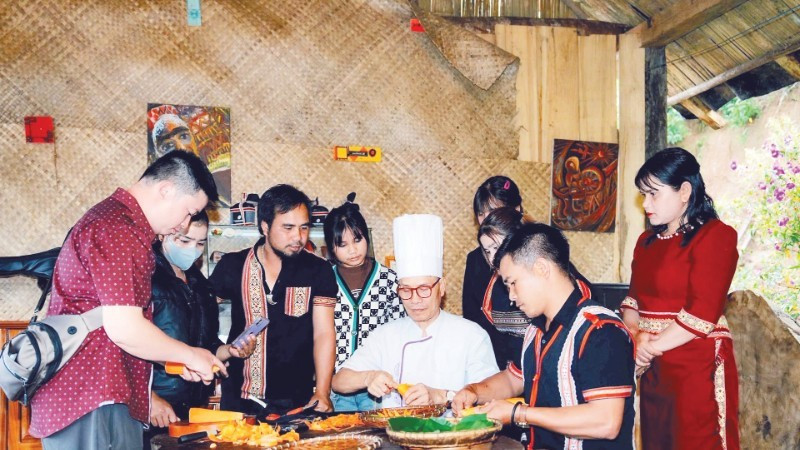The story of a coffee village embracing tourism
Nestled among the majestic mountains and lush coffee plantations of Mang Den Commune (Quang Ngai Province), Kon Chenh Village stands out as a rustic yet charming destination. More than just a stopover for nature lovers and connoisseurs of aromatic coffee, visiting Kon Chenh is also a journey into the unique indigenous culture of the Mo Nam people.

The flavour of hospitality
From Mang Den Town, a six-kilometre road winds through pine hills and slopes will bring you to Kon Chenh Village. In recent times, Kon Chenh has frequently been featured on travel forums and social media, with inspiring stories about a community that is preserving its identity while finding new ways to develop.
In a wooden house, hostess Y Ha welcomed guests with a warm smile and a fragrant cup of freshly brewed coffee. Every gesture, from roasting and grinding the beans to brewing and serving, reflected her pride in the coffee she grew herself.
“Weekends are the busiest,” she said. “Visitors love to enjoy bamboo-tube rice, grilled pork, and rice wine sipped through straws, as well as to listen to the sound of gongs at night. Some offer feedback, others give compliments, all of which encourage me to learn and improve our hospitality.”
Y Ha and her husband, A Nac, were among the first households in the village to open a homestay in 2023. Using their savings and a social policy loan, they transformed over 700 square metres of garden into a retreat.
Local materials such as wood, bamboo, rattan, and stone were used to create a space imbued with the characteristics of the Mo Nam — a branch of the Xo Dang ethnic group — featuring a glowing hearth, gongs, and woven backpacks on the walls, and jars of rice wine neatly arranged in a corner.
Next door, Y The, Secretary of Kon Chenh Village, also began hosting guests in early 2025. “Kon Chenh has long been home to the Mo Nam people,” she explained. “We’ve maintained many traditional cultural values, festivals and folk knowledge, such as the new rice celebration, water-source worship, rice-seeding ritual, gong performances, xoang dance, and folk songs.”
Her house is beautifully renovated, with wooden statues standing amid clusters of blooming purple flowers. Since the whole village joined hands to beautify their surroundings, Kon Chenh has remained tidy and welcoming, even though many households still face financial difficulties. At the entrance to the village lives 37-year-old Y Tuan, regarded as a key figure of community-based tourism in Kon Chenh. She welcomes guests while tending to her vegetable beds.
Since opening her homestay in 2024, Y Tuan has hosted visitors from Da Nang, Gia Lai, Ha Noi, Ho Chi Minh City, and even from China, Russia, and the United States. “Guests love going into the garden to pick vegetables, weed the beds, and prepare meals on-site. Everything is truly home-grown, which they find fascinating,” she said. Known as the village’s talented cook, Y Tuan prepares both traditional and creative dishes. She also acts as a local coordinator for purchasing and distributing angelica ginseng, a valuable local medicinal herb, helping to create additional livelihoods for villagers.
These stories are just small fragments of a broader picture: 110 households, nearly 90% of them Mo Nam people, are working together to build a community-based tourism village in the highlands. Traditional crafts such as rattan weaving, brocade weaving and musical instrument making, once solely for daily use, are now sold at local markets, the Mang Den night economy area, and even across the country through visiting tourists.
In the past, villagers relied mainly on rice and cassava. Today, thanks to coffee, homestays and experiential services, many families earn between 10 and 12 million VND a month, enjoying a more stable and comfortable life. The village currently has eight homestays in operation.
At Kon Chenh, visitors can unwind in the fresh, cool highland air and savour the distinctive flavours of Mo Nam cuisine, including stream fish, pork, buffalo meat, forest vegetables, cassava leaves, and upland rice. Those who enjoy physical activity can join in coffee harvesting, trekking through nearby forests and waterfalls, sit and listen to old A Le play the ta vau (a flute-like instrument), or watch old A Nuong weaving baskets or teaching children to play the gongs.
A dream of sustainable tourism
The road around the village is still winding and slippery in the rainy season, and mobile and internet signals remain unstable. The Mo Nam people are friendly and hospitable, yet many still lack the skills needed to welcome and serve visitors.
The cultural space of gongs and traditional festivals is remarkable, but without proper orientation and organisation, the risk of commercialisation is real. These are the practical issues that must be addressed for sustainable tourism development: creating livelihoods while preserving the essence of long-standing cultural values.
Encouragingly, Kon Chenh boasts a dynamic younger generation, people like Y Tuan, Y The, and A Nac, alongside elders who are deeply knowledgeable and passionate about passing down their ethnic culture. As evening falls, beside the glowing fire, artisan A Le (born in 1956) cradled his ta vau and played a lilting melody.
“It would be heartbreaking if no Mo Nam people knew how to make or play the ta vau anymore,” he said. In recent years, as Kon Chenh has become a favourite destination for travellers, the sounds of the ta vau, the gongs, and folk songs have echoed through the village more often.
And, of course, one cannot forget a distinctive feature that draws visitors to Kon Chenh: the rich aroma and bittersweet flavour of its pure, highland-grown coffee, cultivated for three to four years. Each harvest season, villagers handpick the ripest cherries and soak them to select the finest, densest beans.
At 1,200 metres above sea level, the favourable soil and meticulous care have created a well-loved brand of cool-climate coffee. Over the years, 21 households have partnered with a cooperative to develop a 12-hectare raw material area, with plans to plant another 30 hectares within 2025.
The village’s community tourism group works in an organised way, dividing members into teams for accommodation, food supply, weaving, and gong-dance performance. This structure ensures everyone has a role, an income, and mutual support. Villagers also actively join training courses on hospitality and tourism promotion via social media, gradually developing more diverse and professional services.
Most recently, at the end of August, Hue Tourism College launched a training course on homestay management and operations, granting certificates to Kon Chenh villagers. Meanwhile, the Mang Den Commune People’s Committee has approved a 2025-2030 plan to develop Kon Chenh into a cultural and culinary space, a distinctive destination for coffee and festivals, linked with the sale of local agricultural products.
Developing tourism requires patience and determination. When we visited, roads were still under construction, making travel difficult. Yet the villagers remain optimistic: once the routes are complete, more tourists will come. “We want visitors not only to enjoy our coffee, but also to feel the Mo Nam spirit through our cultural and culinary tourism, our gongs, and our dances,” said Y The, Secretary of Kon Chenh Village.








